A box culvert is a type of culvert—a structure that allows water to flow under a road, railway, trail, or other obstruction—that's shaped like a box. It's a simple yet crucial component of infrastructure, ensuring safe and efficient water management across various landscapes. This guide will delve into the specifics of box culverts, addressing common questions and offering a comprehensive overview of their design, construction, and applications.
What are the Different Types of Box Culverts?
Box culverts aren't all created equal. They come in various materials and configurations, each suited to different conditions and project requirements. Common variations include:
- Precast Concrete Box Culverts: These are manufactured off-site and then transported and installed, often leading to faster construction times. They're durable and resistant to many environmental factors.
- Cast-in-Place Concrete Box Culverts: Constructed on-site, these offer greater flexibility in terms of size and design to fit specific needs and challenging terrains.
- Corrugated Metal Box Culverts: These are lightweight and relatively easy to install, making them suitable for smaller projects. However, their lifespan might be shorter compared to concrete alternatives.
- Plastic Box Culverts: These are gaining popularity for their lightweight nature, corrosion resistance, and ease of installation. However, their suitability depends heavily on the project's specific requirements and environmental conditions.
The choice of material significantly impacts the culvert's lifespan, maintenance needs, and overall cost-effectiveness.
How are Box Culverts Constructed?
The construction process varies slightly depending on the type of box culvert. Precast concrete culverts involve excavation, preparation of the base, and placement of the prefabricated units. Cast-in-place culverts require formwork construction, reinforcement placement, and concrete pouring. Both methods require careful attention to detail to ensure proper alignment, drainage, and structural integrity.
What are the advantages of using box culverts?
Box culverts offer several key advantages:
- High Load Capacity: They can effectively handle significant traffic loads, making them suitable for roads and railways.
- Large Cross-Sectional Area: This allows for efficient water flow, minimizing the risk of flooding and erosion.
- Ease of Installation (for precast): Precast units simplify and speed up the installation process.
- Relatively Low Maintenance: Properly constructed and installed box culverts require minimal maintenance over their lifespan.
- Versatility: They can be used in a wide range of applications and terrains.
What are the disadvantages of box culverts?
Despite their advantages, box culverts also have some drawbacks:
- High Initial Cost (for some types): Cast-in-place concrete structures can be expensive initially.
- Susceptibility to Scouring: The area around the culvert's outlet can be vulnerable to erosion if not properly protected.
- Potential for Sediment Buildup: Sediment can accumulate within the culvert over time, reducing its capacity.
- Limited Flexibility in Complex Terrains: Adapting the design to extremely challenging terrain might require specialized engineering.
What are the Applications of Box Culverts?
Box culverts find applications in a wide array of infrastructure projects, including:
- Roads and Highways: Allowing water to flow under roads and preventing flooding.
- Railways: Facilitating water drainage under railway lines.
- Trails and Paths: Providing passage for water under pedestrian and recreational trails.
- Agricultural Drainage: Managing water flow in agricultural lands.
- Stormwater Management Systems: Helping to divert and manage stormwater runoff.
What are the factors to consider when designing a box culvert?
Designing a box culvert requires careful consideration of several crucial factors:
- Hydraulic Design: Determining the appropriate size and shape to handle expected water flow.
- Structural Design: Ensuring the culvert can withstand the imposed loads and environmental conditions.
- Material Selection: Choosing the appropriate material based on factors like cost, durability, and lifespan.
- Geotechnical Considerations: Understanding soil conditions and potential ground movements.
- Environmental Impacts: Minimizing environmental disruption and ensuring compliance with regulations.
By understanding the different types, construction methods, and applications of box culverts, engineers and contractors can ensure the selection and installation of suitable structures for various projects, promoting efficient water management and long-term infrastructure sustainability.
